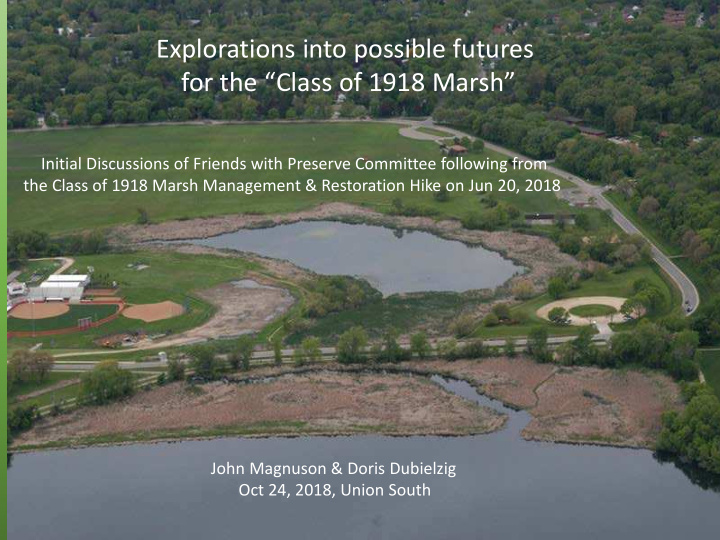



Explorations into possible futures for the “Class of 1918 Marsh” Initial Discussions of Friends with Preserve Committee following from the Class of 1918 Marsh Management & Restoration Hike on Jun 20, 2018 John Magnuson & Doris Dubielzig Oct 24, 2018, Union South
“The Class of 1918 Marsh” serves both as: 1. A storm water retention pond on the campus 2. A severely disturbed wetland in a nature preserve. Our hike was to help judge the feasibility of rehabilitating some of its qualities as a wetland in a Nature Preserve. Rehabilitation is the goal as a restoration of its original condition is impossible.
South Inlet Sep 24, 2017 Sep 23, 2018 Apr 8, 2013 Mar 12, 2013
South Bridge Looking south Looking north Jan 19 2013 Apr 29, 2013 Oct 8, 2017 Oct 22, 2016
North Bridge Apr 8, 2013 Sep 26. 2015 Sep 23, 2018 Sep 23, 2018
Pump House Mar 27, 2013 Apr 29, 2013 May 23, 2013
Recommendations on flow Improve the free flow of water through the marsh and regulate water levels to be high in the spring and low during fall and winter. • Clean out the drain from the open marsh to the pumphouse. • Clean out the culvert to the South Inlet, which usually drains relatively clean water from the hospital complex. • Remove vegetation from the channel flowing into the marsh. This will improve water flow into the marsh.
Recommendation on water levels • Lower the water level in the marsh, beginning at the end of the summer. • In the spring, flood the marsh again.
Class of 1918 Marsh (1995 versus 2014) 1995 2014 Magnuson using Dane County GIS Services
Recommendation on reducing cattails • In the winter, when the ice is solid, drive a tractor and (PTO driven side cutter) hay cutter onto the ice to mow the cattails and other plants. Remove the cut vegetation in the winter. • Consider several demonstration sites of 100m x 100m areas for winter cutting and biomass removal. One could be at the viewing platform on the northwest side and another along the east trail where the cattail band is most narrow. Consider a small floating dock here to improve access and viewing and dip-netting the open waters.
Sedges along the west marsh path • Mowing the sedges west of the west path around the marsh will have a positive effect on the sedges. What season? • Consider this as part of the re-establishment of the wetlands along both sides of the west path.
Recommendation on the sediment. • Do not remove the 50 cm of organic sediment in the open marsh. • More trouble with permitting than it is worth.
Recommendation on burning the cattail residue. • For the first 5 - 10 years, following the winter mowing of the cattails, burn the residue. This will release nutrients and speed the demise of the cattails. • Burn if you can but plan carefully and consider how to do it. • If unable to burn, might have to haul the cut material to another site.
Recommendation on road salt • Continue to be creative on reducing the application of road salt. • Lowering winter water levels and increasing the channel from the marsh to the pump house will remove more road salt from the marsh than present practices.
Research & monitoring • Check engineering for the the water levels that are possible and the issue of flooding. • Begin monitoring now with photo points and document every action from the beginning. Magnuson has been photographing from some points somewhat regularly since 2013. Include the early March photo time series of the snow pile. • Having UW students do a seed study, to determine what seed bank remains, could be informative. • Continue measurements of the chloride or the electrical conductivity of the Marsh waters. (Magnuson and Dugan) • Continue to estimate the amount of sand and salt applied on the campus • Encourage a groundwater study of flow and chemistry of waters entering the marsh from the snow pile and the playing fields. • Get City & County health to measure contaminants in the sediments in the open Marsh.
Rehabilitation Summary 1. Implement seasonal fluctuation of water levels. Let reestablishment of water level processes play out over the years. Be persistent and observe responses. (University staff and Friends) 2. Demonstration project to test how well cutting and removal of cattail biomass works on two 100 by 100 m plots at viewing platform and canoe landing. 3. Establish a photo history from the beginning. (Friends and staff) 4. Encourage research on the marsh (groundwater, seedbanks). Students) 5. Research the prior history of the marsh. (Friends) 6. Observe, persist, and apply “adaptive management.” (all) Do not: 1. remove sediment. 2. add plantings. 3. quit as this is a long-term effort. 4. over promise.
Good things West Path Apr 2013 West Path Sep 2018 Ice covered open Marsh Mar 2018 East Path Jul 2015
More good things
Recommend
More recommend